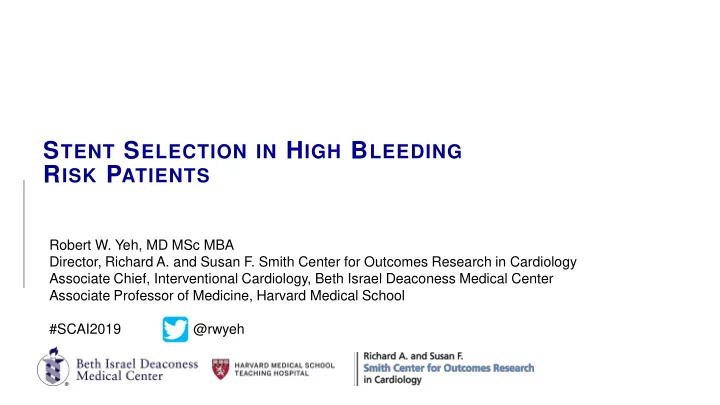

S TENT S ELECTION IN H IGH B LEEDING R ISK P ATIENTS Robert W. Yeh, MD MSc MBA Director, Richard A. and Susan F. Smith Center for Outcomes Research in Cardiology Associate Chief, Interventional Cardiology, Beth Israel Deaconess Medical Center Associate Professor of Medicine, Harvard Medical School #SCAI2019 @rwyeh
Funding and Disclosures Non-Industry Funding NHLBI R01 HL136708-01 (EXTEND Study) NHLBI K23 HL118138 (DAPT Score) Richard and Susan Smith Center for Outcomes Research in Cardiology Industry Disclosures Research Grants: Abbott Vascular, Abiomed, AstraZeneca, Boston Scientific Advisory Board: Abbott Vascular, Boston Scientific, Medtronic Consulting: Abbott Vascular, Asahi, Boston Scientific, Merck, Teleflex Richard� A.� and� Susan� F.� Smith� Center� for� Outcomes� Research� in� Cardiology�
Stent Selection in HBR What type of stent would you use in HBR patients? 1) DES vs. BMS 2) If DES, which? Richard� A.� and� Susan� F.� Smith� Center� for� Outcomes� Research� 3 in� Cardiology�
Crowdsourcing Richard� A.� and� Susan� F.� Smith� Center� for� Outcomes� Research� in� Cardiology�
What is the state of evidence? ◼ Randomized trials comparing stent types among high bleeding risk patients ◼ Observational registries of early DAPT discontinuation with current DES ◼ Single arm IDE trials of planned short DAPT duration Richard� A.� and� Susan� F.� Smith� Center� for� Outcomes� Research� 5 in� Cardiology�
Randomized trials comparing stents in HBR patients ◼ LEADERS-FREE (and ZEUS) – Comparison of polymer-free DES to BMS among HBR patients ◼ SENIOR – Comparison of bioresorbable-polymer DES to BMS among elderly patients ◼ ONYX ONE – Comparison of durable polymer DES to polymer-free DES among HBR patients Richard� A.� and� Susan� F.� Smith� Center� for� Outcomes� Research� 6 in� Cardiology�
LEADERS FREE – BioFreedom PF-DES vs BMS Patients received 1 month DAPT Urban et al. NEJM 2015. Richard� A.� and� Susan� F.� Smith� Center� for� Outcomes� Research� 7 in� Cardiology�
SENIOR: BMS vs. BP-DES in the Elderly Population: 1200 pts age 75 or older AF undergoing PCI for stable, silent ischemia, or acute CAD. Intervention: Randomized 1:1 to DES (Synergy) vs. BMS with 1 or 6 SENIOR month DAPT based on presentation. Presented as LBCT at #TCTDenver Primary Endpoint: Death, MI, stroke or ischemia-driven TLR at 1 year.
Primary Endpoint at 1 year Death, MI, stroke or ID-TLR 16% BMS vs. 12% DES HR 0.71 (0.52-0.94) ~50% stopped DAPT at 1 month, 30% between 1 and 6, and 20% continued for year
Components
Randomized Data for Durable Polymer stents
Data from Registries - ZES Silber et al. EHJ 2014. Richard� A.� and� Susan� F.� Smith� Center� for� Outcomes� Research� 14 in� Cardiology�
Data for CC-EES Natsuaki et al. Cardiovasc Interv and Ther. 2015. Genereux et al. Circ Intv 2015. Richard� A.� and� Susan� F.� Smith� Center� for� Outcomes� Research� 15 in� Cardiology�
Studies Ongoing ◼ EVOLVE Short DAPT - SYNERGY stent, 3 months of DAPT ◼ Xience 90/28 – Xience stent, 3 months rolling into 1 month of DAPT ◼ Onyx One Clear (US) – 1 month of DAPT ◼ All will compare ischemic and bleeding event rates against historical/non- randomized controls. Richard� A.� and� Susan� F.� Smith� Center� for� Outcomes� Research� in� Cardiology�
Conclusions ◼ What has been shown in head to head trials of stents? – PF-DES (BioFreedom) beats BMS in HBR on ischemic endpoints – BP-DES (Synergy) beats BMS in elderly patients given 1 month and 6 months of DAPT ◼ What’s coming? – Ongoing studies will help determine the rates of ischemic events among a generalizable group of HBR patients with planned receipt of 1-3 months of DAPT with the most commonly used stents. ◼ There is a hazard for reducing DAPT duration that is mitigated, but not eliminated, by newer stent designs. Richard� A.� and� Susan� F.� Smith� Center� for� Outcomes� Research� 17 in� Cardiology�
Thank you! E: ryeh@bidmc.harvard.edu @rwyeh
Recommend
More recommend